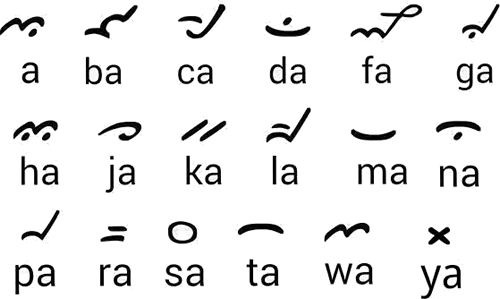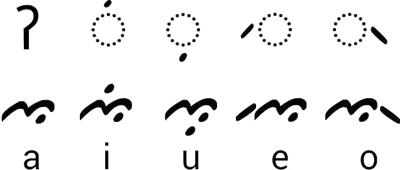Bima, or Bimanese, is a Malayo-Polynesian language spoken in the eastern half of Sumbawa Island in Indonesia by about 500,000 people. It is closely related to the languages of Sumba Island.
The Bima(nese) script is used to write Bima, and is related to the Buginese script. This script has been used since the 14th century, and was used to write books and royal records in the Bima Kingdom. During the 17th century, when the Bima people became Muslim, they started using Malay written with the Arabic script.
The research on Bimanese Literacy was initiated by Hj. Siti Maryam R Salahuddin, a princess of the last Sultan of Bima. The research started from the time that she founded the Bimanese script in a record by Zollinger (1850) and a record by Raffless (1978) which were obtained from the Perpustakaan Nasional RI (Indonesian National Library) in Jakarta in 1987. In 1990-1991 a study was conducted to describe the content of a copy of a palm-leaf manuscript from Leiden which bought by J. Noorduyn, a Professor of Buginese language from Leiden University, based on those script records. A team was formed to continue the research consisting of Hj. Siti Maryam, Syukri Abubakar, and Munawar Sulaiman. The wrote about their findings in a book entitled "Aksara Bima, peradaban lokal yang sempat hilang" (Bimanese Script, a local civilization that had disappeared).


There are some nasal sounds in the Bima language. Some of them have their own letter: mpa, nca, nta, nga, while others can become nasal depending on the context of the sentence: mba -> ba; nda -> da; ngga -> ga.

The consonants Q, V, X, and Z do not exist in the Bimanese script and are replaced by those with a similar sound.

Download an alphabet chart for Bima (Excel)

Dowu ma pertama mabade warana aksara mbojo ededu putri Maryam R Salahuddin deyi salelana kertas ma tunti kayi aksara mbojo mamayi ta dowu Belanda.
Hear a recording of this text by Sisitimur, a native speaker of Bima from Sumbawa. Recorded by Moshe Ash
The first person who knew about the existence of Bimanese script was princess Maryam R Salahuddin from a record written in Bimanese script by a Dutch researcher.
Information mainly supplied by Ridwan Maulana. If you have any questions about this script, you can contact Ridwan at ridwanmaul768@gmail.com

Information about Bima
https://en.wikipedia.org/wiki/Bima_language
https://fr.wikipedia.org/wiki/Bima_(langue)
http://www.ethnologue.com/language/bhp
Alorese, Ambai, Ambel, Anuki, Balinese, Bambam, Batuley, Biak, Bima, Bugis, Chamorro, Duri, Enggano, Fijian, Fordata, Gayo, Iban, Javanese, Kei, Komering, Lamaholot, Lampung, Ledo Kaili, Madurese, Makasarese, Mamasa, Mandar, Mandar, Mbula, Mentawai, Mualang, Musi, Ngaju, Nias, Nuaulu, Ogan, Palauan, Sasak, Selaru, Sumbawa, Sundanese, Toqabaqita, Toraja-Sa'dan, Ulumandaʼ, Wamesa, Yamdena
Ahom, Aima, Arleng, Badagu, Badlit, Basahan, Balinese, Balti-A, Balti-B, Batak, Baybayin, Bengali, Bhaiksuki, Bhujimol, Bilang-bilang, Bima, Blackfoot, Brahmi, Buhid, Burmese, Carrier, Chakma, Cham, Cree, Dehong Dai, Devanagari, Dham Lipi, Dhankari / Sirmauri, Ditema, Dives Akuru, Dogra, Ethiopic, Evēla Akuru, Fox, Fraser, Gond, Goykanadi, Grantha, Gujarati, Gunjala Gondi, Gupta, Gurmukhi, Halbi Lipi, Hanifi, Hanuno'o, Hočąk, Ibalnan, Incung, Inuktitut, Jaunsari Takri, Javanese, Kaithi, Kadamba, Kamarupi, Kannada, Kawi, Kharosthi, Khema, Khe Prih, Khmer, Khojki, Khudabadi, Kirat Rai, Kōchi, Kodava Lipi, Komering, Kulitan, Kurukh Banna, Lampung, Lanna, Lao, Lepcha, Limbu, Lontara/Makasar, Lota Ende, Magar Akkha, Mahajani, Malayalam, Meitei (Modern), Manpuri (Old), Marchen, Meetei Yelhou Mayek, Meroïtic, Masarm Gondi, Modi, Mon, Mongolian Horizontal Square Script, Multani, Nandinagari, Newa, New Tai Lue, Ojibwe, Odia, Ogan, Pahawh Hmong, Pallava, Phags-pa, Purva Licchavi, Qiang / Rma, Ranjana, Rejang (Kaganga), Sasak, Savara, Satera Jontal, Shan, Sharda, Sheek Bakrii Saphaloo, Siddham, Sinhala, Sorang Sompeng, Sourashtra, Soyombo, Sukhothai, Sundanese, Syloti Nagri, Tagbanwa, Tai Noi, Takri, Tamil, Tanchangya (Ka-Pat), Tani, Thaana, Telugu, Thai, Tibetan, Tigalari, Tikamuli, Tocharian, Tolong Siki, Vatteluttu, Warang Citi
Page last modified: 06.01.25
[top]
You can support this site by Buying Me A Coffee, and if you like what you see on this page, you can use the buttons below to share it with people you know.

If you like this site and find it useful, you can support it by making a donation via PayPal or Patreon, or by contributing in other ways. Omniglot is how I make my living.
Note: all links on this site to Amazon.com, Amazon.co.uk
and Amazon.fr
are affiliate links. This means I earn a commission if you click on any of them and buy something. So by clicking on these links you can help to support this site.
[top]